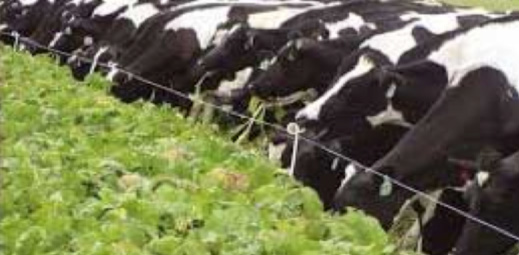With the huge demand for fodder this winter due to difficult weather conditions throughout the year, many farmers have opted to sow forage crops to graze in situ over the winter to reduce demand on silage stocks. There has been a considerable increase in the acreage of brassica crops such as kale, forage rape, hybrid brassicas (Redstart), stubble turnips and swedes. These crops can provide nutritious, cost effective feeds for beef cattle and sheep. Many farmers may find themselves grazing brassicas for the first and quite possible on land that has never seen livestock in decades. Grazing of Brassicas is not for the faint hearted and it is essential to be prepared and informed.
Typical Yields and Analysis of Brassicas
|
Crop |
Expected DM yield (t DM/Ha) |
DM% |
CP% |
Metabolisable energy (MJ/kg DM) |
|
Kale |
10-12 |
14-16 |
16-18 |
12.5-13.5 |
|
Fodder Rape |
4-6 |
12-14 |
18-20 |
10-11 |
|
Hybrid Brassica |
6-8 |
12-14 |
18-20 |
10-11 |
The key to successful feeding with forage crops is to strip graze, using a temporary electric fence to maximise crop utilisation.
- Each grazing strip (break) should be long and narrow. Strip grazing small areas will provide the most efficient utilisation.
- Introduce stock to the crop slowly on full stomachs to avoid digestive upsets.
- Brassicas must form no more than 70% of the diet, feeding a source of effective fibre such as hay, straw or silage is crucial.
- It is a necessity that a wide-access run-back area is provided, in accordance with good agricultural practice.
- Start grazing from the top of a sloping field, rather than the bottom, to reduce run-off.
- Avoid channelling stock through gateways to adjoining fields to minimise poaching
- Two strip wires should be in place at all times, the second fence provides back up in the event of livestock breaking down the primary wire.
Cattle
Growth rates for growing cattle out-wintered on brassicas are reported to be between 0.6-0.9kg/day, although cattle can lose weight in the first weeks of grazing before growth rates are established. Gradual introduction to the crop reduces the risk of weight loss.
Lambs
Brassicas are good sources of feed for holding or finishing store lambs and finishing cull ewes combined with concentrates. Growth rates of up to 250g per day are achievable. These lamb growth rates can be achieved with adequate supplementation.
Clostridial Diseases
There is a higher risk of the occurrence of these diseases as livestock are more likely to come into contact with spores in the soil, due to mucky/bare ground. Ensure livestock have received their 2 shots of a Clostridial vaccine.
Nitrate poisoning
Cause: Nitrates accumulating in the leaves of the crop. Usually occurs where fast growing crops are grown in soil with high nitrate levels after rain which has followed a dry spell. Also, cool and overcast conditions and high N fertiliser use will increase the risk.
Effect: Abdominal pain, scour, weakness, muscle tremors, drooling, mouth breathing or coma. Can cause death. May look like milk fever.
Treatment: Remove stock and feed high quality forage. The vet may recommend the use of methylene blue.
Prevention: Introduce non-hungry stock slowly and avoid high use of nitrogen fertiliser.
Mineral supplementation
At Drummonds we advise that cattle and sheep should receive an Alltrace mineral bolus 2-4 weeks before introduction to the crop. Stock can also be offered minerals in the form of mineral buckets or blocks. Iodine supplementation is essential. Goitrogenic substances are found in most forage crops and interfere with the use of iodine by the thyroid. They are also low in trace elements:
- Copper Iodine 3. Selenium
Forage crops tend to be high in calcium and low in phosphorus and magnesium, which may pre-dispose pre-calving cows to hypocalcaemia if they are not fed low calcium forage. For this reason, remove pregnant animals from brassicas 4-6 weeks before due date.
Crops should be grazed out before flowering; flowering brassica crops are poisonous. Aim for the final grazing to be completed before mid-March



